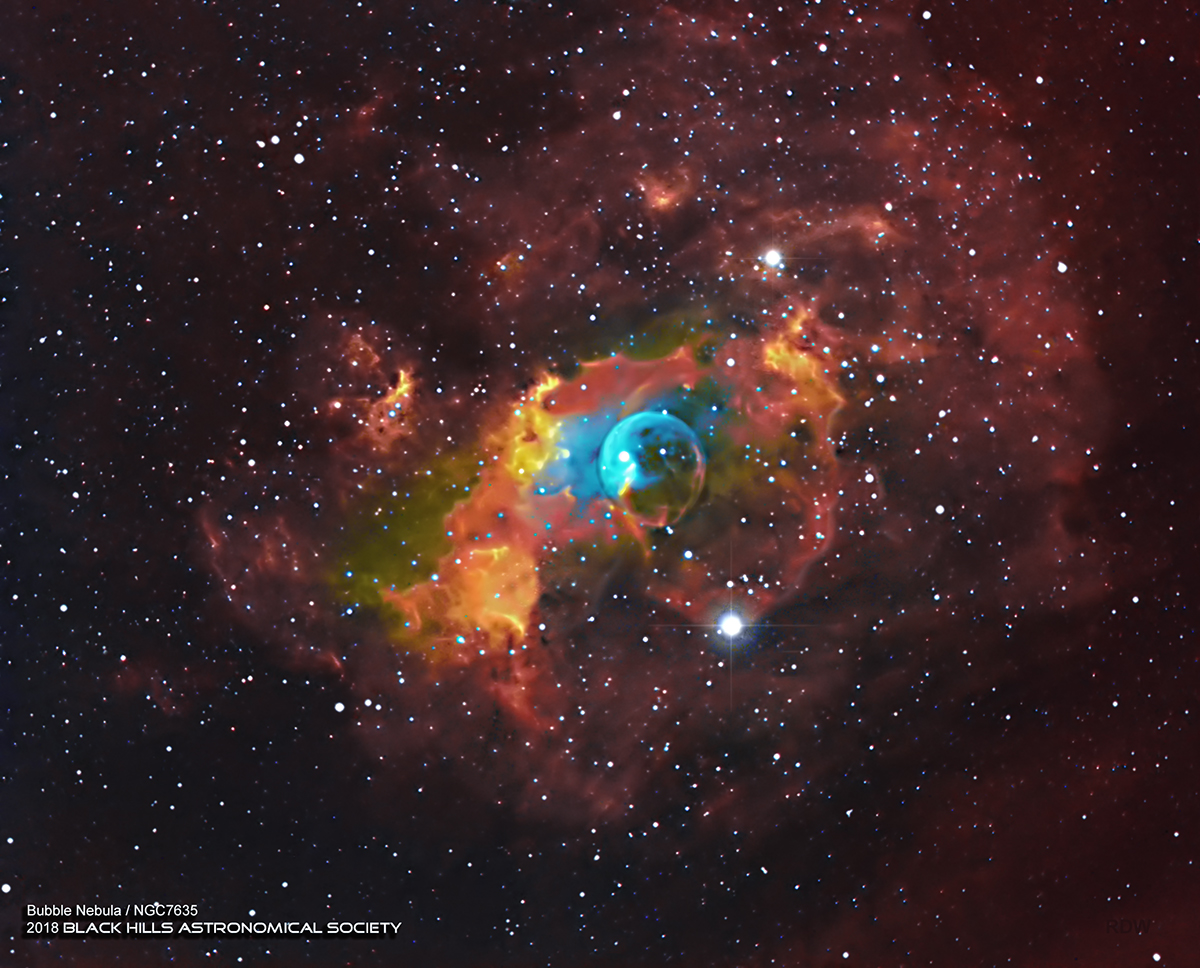

The Bubble Nebula (NGC7635) ... "The Christmas Bubble": posted by Richard D. Walker, Black Hills Astronomical Society Observatory Director <https://www.sdbhas.org>
A bubble is defined as a globule of one substance in another, usually gas or liquid. Out of all the substances that can produce a bubble, stars are probably not the first thing that comes to mind for most folks. Or that Earth, spinning in the vacuum of space, is a bubble of sorts supporting life as we know it. But bubbles in space can be incredibly larger than the one created by our planet.
Which brings us to NGC 7635, the Bubble Nebula. NGC 7635 is really just a star, ok a super hot massive star, blowing an enormous bubble of material into space. Some stars, and most kids, like to blow bubbles too. I know, there’s a lot of weird stuff in space.
So how does a star blow a bubble? The star in NGC 7635 is 45 times more massive than our sun, called BD +602522. Gas in the outer atmosphere of the star gets so hot that it escapes away into space as a “stellar wind” moving at more than 4 million miles per hour. This outflow sweeps up the interstellar gas in front of it, forming the outer edge of the bubble much like a snowplow piles up snow in front of it as it moves forward. Astronomers calculate that the star was born with about 60 times the sun’s mass and has shed one quarter of its material in this mass-loss wind. (Source: NASA, ESA)
You may be wondering how “incredibly large” is this Bubble Nebula? The answered to that question was provided by BHAS Math Professor Donald Teets of the SDSM&T: “Find the ratio of the nebula’s volume to the earth’s volume. That ratio is (3 ly)^3 / (4000 mi)^3. Three light years is about 1.7637 x 10^13 miles, so the appropriate ratio is (1.7637 x 10^13)^3 / 4000^3, which is about 8.57 x 10^28.
That is, the (Bubble) nebula would hold 85,700,000,000,000,000,000,000,000,000 Earths. (85,700 with 24 zeros tacked on.)
So as you look at the Bubble Nebula image, even a single pixel would be too large to represent Earth to scale here! And that was a conservative estimate based on the assumption of the bubble being 6 light years across; but it could be as much as 10 light years.
Something 6 light years across should be easy to find, right? Well, the Bubble Nebula is in the constellation Cassiopeia but it’s 7,100 light-years from us. Easy or not, it was discovered in 1787 by British astronomer William Herschel and cataloged by his sister Caroline Herschel, the first woman to discover a comet.
The star blowing the bubble in NGC 7635 is about 4 million years old, and in 10 to 20 million years it will likely detonate as a supernova.
Prior to that ever occurring, seven months before Armstrong and Aldrin of Apollo 11 stepped onto the moon, Apollo 8 launched from Cape Kennedy on December 21, 1968. Astronauts James Lovell, Frank Borman and William Anders left Earth atop a giant 364-foot-high Saturn V rocket, with 7.5 million pounds of thrust exploding out of five F-1 rocket engines. After the translunar injection burn there were three men in our solar system who would have to be counted apart from the rest of humanity. They were in a unique place, outside the earth’s gravitational field and sailing into outer space, headed for the moon. And that had never been done before.
For the first time man could examine planet Earth at a great distance. And on Christmas Eve, for the first time a human would take hold of a camera and photograph the Earth as it rose above the Moon’s surface.
Compared to the Bubble Nebula our planet is small indeed. Nonetheless, it is a beautiful bubble with a radiance that harbors life. A place where our survival, and the survival of a great many other species, depends on how well we learn to live and work together to restore what is broken.
And from the crew of Apollo 8, we close with good night, good luck, a Merry Christmas and God bless all of you—all of you on the good Earth. Apollo 8 Commander, Frank Borman. December 24, 1968
NGC 7635 was captured at the BHAS Observatory, Rapid City, SD, December 2018.
Imaging platform: Meade 12″ LX200, ATIK16200, ZWO ASI174MM guide, Astrophotography Tool (APT) plate solve and capture.
Total integration time: 10 hours 30 minutes, 3hrs. SII, 3hrs-50min. Ha, 3hrs-50min. OIII.
Data acquisition by Richard D. Walker and Chris Konvalin. Compiled by Richard D. Walker. Hubble color pallet, SHO.